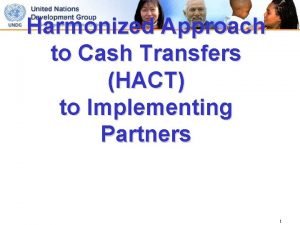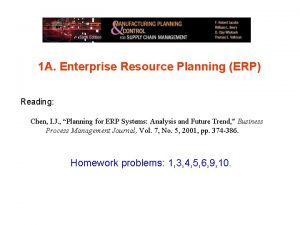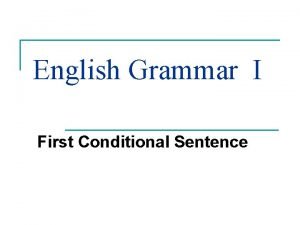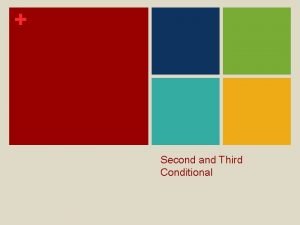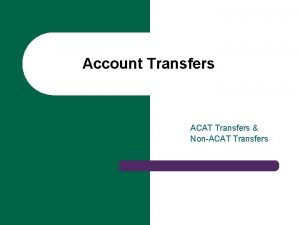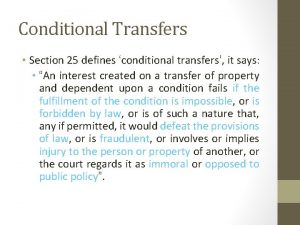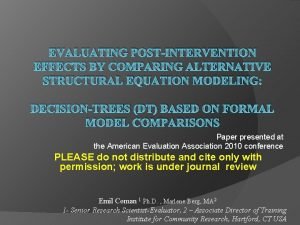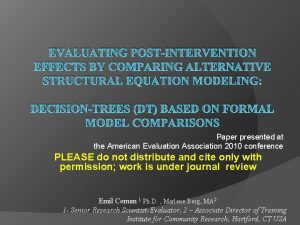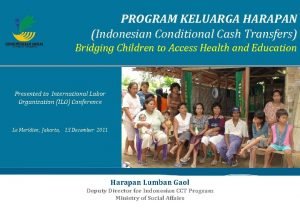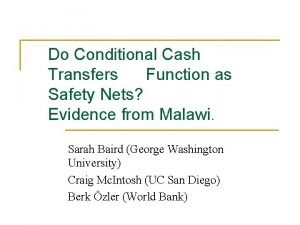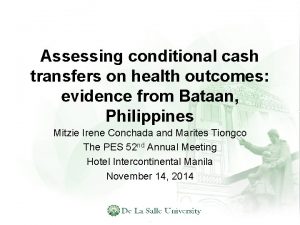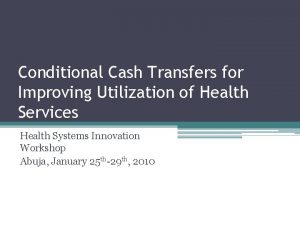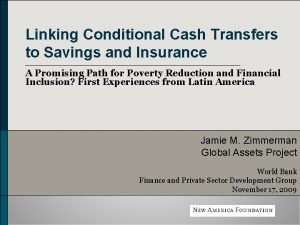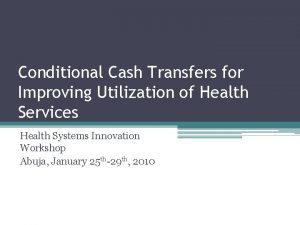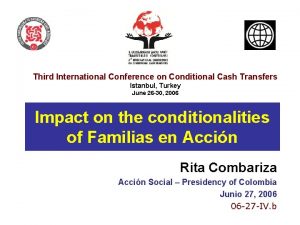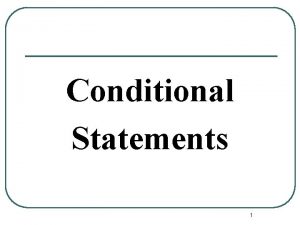The postintervention effects of conditional cash transfers for



















- Slides: 19

The post-intervention effects of conditional cash transfers for HIV/STI prevention: a randomized trial in rural Tanzania Damien de Walque (The World Bank) William H Dow (University of California - Berkeley) Rose Nathan (Ifakara Health Institute) The RESPECT study team International AIDS Conference Amsterdam July 26, 2018

STIs? HIV? STIs HIV

STIs? HIV? STIs HIV

Study Population (N=2, 409) Control (N=1, 124) Treatment (N=1, 285) $10 if STI-free (N=660) $20 if STI-free (N=615)

Study Population (N=2, 409) Control (N=1, 124) Treatment (N=1, 285) $10 if STI-free (N=660) Relative risk (compared to control, adjusted) 4 STIs : 1. 06 $20 if STI-free (N=615) Relative risk (compared to control, adjusted) 4 STIs : 0. 73 (p<0. 05)

Study Population (N=2, 409) Control (N=1, 124) Treatment (N=1, 285) $10 if STI-free (N=660) Relative risk (compared to control, adjusted) 4 STIs : 1. 06 $20 if STI-free (N=615) Relative risk (compared to control, adjusted) 4 STIs : 0. 73 (p<0. 05)

OVERVIEW �What: “Proof of concept” evaluation of randomized CCT to incentivize reduction in risky sex. �Why: Goal is to decrease STI incidence, with potential subsequent long-run health and economic benefits. – including 1 -year post-intervention health follow-up �How: Condition cash incentives on periodic negative STI tests. �Where: Ifakara Health and Demographic Surveillance Site in rural Tanzania.

INTERVENTION ARMS • Conditionality – Testing negative for the set of curable STIs tested every 4 months. • Rewards (every 4 months) – High-value: 20, 000 TZ Shillings or ~= USD 20 – Low-value: 10, 000 TZ Shillings or ~= USD 10

WHAT IS OFFERED TO THE PARTICIPANTS? Intervention group Control group • Pre and post-test counseling • Group counseling • Relationship-skills training • STI testing • Inconvenience fee • Free treatment for STIs • Conditional cash transfers • Pre and post-test counseling • Group counseling • Relationship-skills training • STI testing • Inconvenience fee • Free treatment for STIs

Chronology and study activities Baseline • • • 4 months 8 months Registration Interviews Counseling* Sample collection Compensation 12 months 24 months Registration Interviews Assignment Counseling* Interviews Sample collection Counseling* Conditional cash Sample collection. Conditional cash Compensation * Pre and post-counseling The post-intervention follow-up, 12 -months later (month 24) will assess long-term biological impact Treatment, group counseling and relationship-skills straining

Effects of CCT at months 4, 8 and 12. 11

Should we pay people life-long in order for them to choose safe sex?

Sustained effects after the end of the intervention? Baseline 4 months 8 months 12 months Conditional cash transfers and STI testing every 4 months for 1 year 24 months No CCTs, No testing For 1 year

1 -Year Post-intervention Follow-Up: Hypotheses (1) Positive sustained risk reduction: Learning (2) Zero long-run effect: Incentives must be continued for sustained effect (3) Adverse long-run effect: The cash transfers destroyed the intrinsic motivation

Results of 1 year post-intervention follow-up • There were no adverse effects 1 -year later (e. g. from destroyed intrinsic motivation). • But gender differences: • Effect sustained among men. • Effect disappeared for women. .

1 -Year Post-Intervention Treatment Effects: by gender and SES 16

Discussion • Cash incentives significantly reduced STIs after 1 year trial. – Effects not evident at early study rounds. – But they were sustained 1 -year post-intervention in some groups, implying a learning model. – There were no adverse effects 1 -year later (e. g. from destroyed intrinsic motivation). • Gender differentials: – Not evident in first year. Suggests income effects did not cause adverse effects on net. – 1 -year post-intervention: • Effect sustained among men. Suggests learning important for men. • Effect disappeared for women. Suggests cash incentives help women at risk.

Future Possibilities? • CCTs are becoming more common in Africa, but CCTs for STI prevention have never been scaled-up anywhere. This study provides a proof of concept, but needs replication. • 1 -Year post-intervention results suggest targeting both men and women initially, then may be reasonable to phase out incentives for men but sustain them for women. • RESPECT not designed for scale-up. Lottery-based and/or employer-based designs may be more feasible.

Thank you
 Terms review 5-3 accounting
Terms review 5-3 accounting Harmonized approach to cash transfers
Harmonized approach to cash transfers Cash to cash cycle time
Cash to cash cycle time What is cash in and cash out
What is cash in and cash out Cash budget benefits
Cash budget benefits Cash to cash cycle time
Cash to cash cycle time Paid cash to replenish the petty cash fund
Paid cash to replenish the petty cash fund First conditional grammar rules
First conditional grammar rules The form of past real conditional
The form of past real conditional Tack för att ni har lyssnat
Tack för att ni har lyssnat Smärtskolan kunskap för livet
Smärtskolan kunskap för livet Novell typiska drag
Novell typiska drag Mjälthilus
Mjälthilus Trög för kemist
Trög för kemist Vad är ett minoritetsspråk
Vad är ett minoritetsspråk Multiplikation med uppställning
Multiplikation med uppställning Delegerande ledarstil
Delegerande ledarstil Toppslätskivling dos
Toppslätskivling dos Adressändring ideell förening
Adressändring ideell förening Borra hål för knoppar
Borra hål för knoppar

